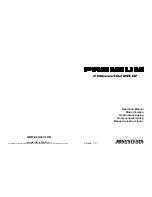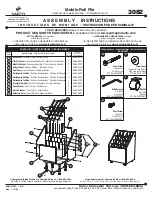
10
Care and Maintenance
COVER
Always keep the mattress/cushion cover as clean as is practicable. The material is waterproof
and vapour permeable.
l
Inspect top cover for signs of damage or wear which could result in the contamination
of the interior, e.g. tears, holes, damage to seams or zips, underside staining, etc. The
frequency of these checks should be at each decontamination process, i.e. between
patients or patient occupancy (or weekly for longer term patients).
l
Care should be taken to avoid puncturing cover with objects such as needles, scalpels,
pat slides, acrylic nails, etc.
l
The cover may be removed and cleaned in accordance with The Revised Healthcare
Cleaning Manual June 2009 subject to the following action: Following the use of a
detergent and or disinfectant solution the mattress cover should be rinsed with clean
water using a clean cloth and allowed to dry.
l
Frequent or prolonged exposure to high concentrations of aggressive disinfectant
solutions will reduce the useful life of the mattress/cushion cover.
l
Where high concentration disinfectants e.g. > 10,000ppm chlorine releasing agent
(e.g. Haztab or bleach) or combined cleaning/chlorine releasing agent (e.g. Chlorcleam,
Actichlor) and detergent solutions are used to remove blood or other body fluids,
mattresses/cushions should be thoroughly rinsed with clean water to remove any
residues. This will help prevent any possible long term compatibility issues associated
with disinfectant residues.*
l
Alternatively disinfection may be achieved by laundering at temperatures not exceeding
65
0
C for 10 minutes or 73
0
C for 3 minutes which may include a chlorine rinse.
l
Do not use abrasive cleaners, phenol disinfectants, solvents or alcohol-based cleansers,
e.g. Dettol, Phenicol, Hibiscrub, Clearsol, Stericol, Hycoline, as these may destroy the
cover materials.
l
Do not iron.
l
Ensure that the mattress/cushion is thoroughly dried before remaking the bed or placing
in storage.
INTERIOR COMPONENTS
l
Check air cells and mattress/cushion interior for signs of damage or contamination,
e.g. staining or evidence of fluid ingress. The frequency of these checks should be at
each decontamination process, i.e. between patients or patient occupancy (or weekly
for longer term patients)
l
Care should be taken to avoid puncturing air cells with objects such as needles, scalpels,
pat slides, acrylic nails, etc.
l
The individual cells can also be wiped clean with a mild antiseptic solution*.
l
All cells are replaceable and can be obtained easily from Talley.
l
Do not immerse the PULSAIR
®
CHOICE mattresses/cushion in water.
l
The QUATTRO
®
range of mattresses are fully launderable, but ensure the CPR device is
fully closed (i.e. the dial of the CPR device is rotated clockwise until it
‘clicks’
into the
closed position ), prior to laundering to prevent water entering the air cells / tubing.






































